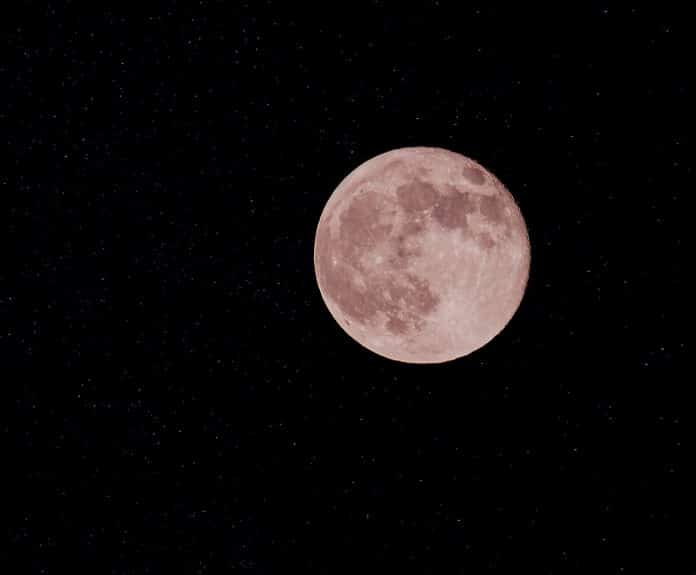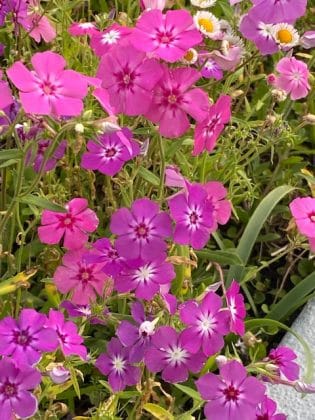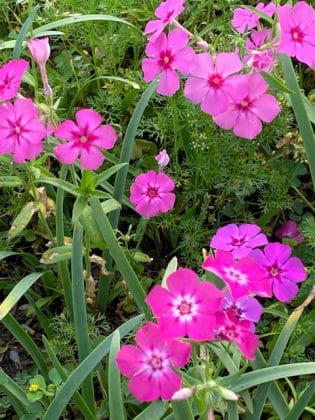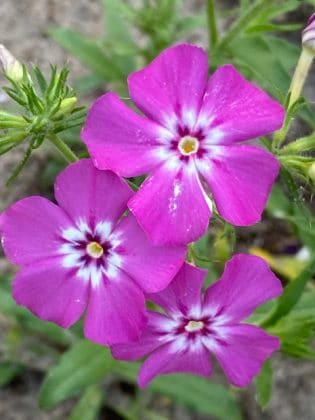Spring is already in bloom by the time April shows us its full moon. The Pink Full Moon is on Saturday, April 16th. The moon will appear full for three nights in a row from April 15 until April 17. Can you imagine how pretty it will look on the night of Easter? It is also called the Paschal Full Moon because it is the first one after the spring equinox on March 20. The word “paschal” relates to Easter and actually comes from the Hebrew word for Passover.
Then why is April’s moon also called Pink Full Moon? It has to do with springtime blooms, particularly a wildflower called phlox subulata, or simply phlox. We are familiar with them. We see those flowers all around us at this time of year. Their clusters of color fill the medians and borders of our rural highways. We spot them suddenly after some warm weather. Soon just a few phlox turn into fields of pinks, whites, and lavenders. They are called creeping phlox or moss phlox, also known as “moss pink.” So that’s where the Pink Full Moon gets its name.
Other names for the April moon have references to spring. Native Americans mentioned an Ice Breaking Moon and a Streams Becoming Navigable Moon. They also saw budding plants and shrubs or red grass and used them to name the moon. They paid attention to the rhythms of nature. Ducks returned, geese laid eggs, frogs appeared, and suckerfish were plentiful in the lakes and streams. Everything returns back just the way nature intended after a long cold winter.
Did you know there are age-old practices of planting flowers and crops by the moon’s phases? It is believed that moon cycles can affect plant growth. Just as gravitational pull causes the tides to rise and fall, it also affects the moisture in the soil. The thought is that seeds will absorb more water during the full moon and new moon when gravitational pull is greatest. More moisture will be pulled to the surface.
So, when is the right time to plant? They say to plant your flowering bulbs, biennial, and perennial flowers when the moon is past full but before the next new moon. The same schedule goes for vegetables that grow below ground such as onions, carrots, and potatoes. They should be planted after the full moon but before the next new moon. This waning moon phase occurs from April 16 through April 30. Each night there is a decrease in the moonlight. During this time plants are encouraged to grow roots, tubers, and bulbs.
Similarly, annual flowers are best planted when the moon is waxing, that is when it’s between new and full moon phases. Your fruit and vegetables that bear crops above ground are supposed to do better then. Dates to keep in mind are from April 30 to mid-May. Crops such as corn and tomatoes are supposed to thrive during a waxing moon. They are encouraged to grow new leaves and stems as the moonlight increases night by night. I’ll have to try this out to see if it really works!
And finally, for you early risers there are some treats, on April 27 you’ll see a thin sliver of the moon against a dark sky before sunrise. Then on April 29 and April 30, you might see the Jupiter-Venus conjunction! These two planets rise within a minute of each other and meet in the predawn sky. They literally do a shuffle and change places over a period of 2-3 days. Look northeast an hour before sunrise. They’ll look like one really bright star!
You may even be fortunate this month to see some meteors! The Lyrid meteor shower is at its predicted peak on April 22. It is one of the oldest known meteor showers, having been observed for over 2,700 years. How do you see meteors? It’s best to view them in a darkened area of your yard. Try anytime from midnight until the moon rises. (2-3 am). Get out a comfy lounge chair and wait. If you are lucky you may spot some shooting stars!




